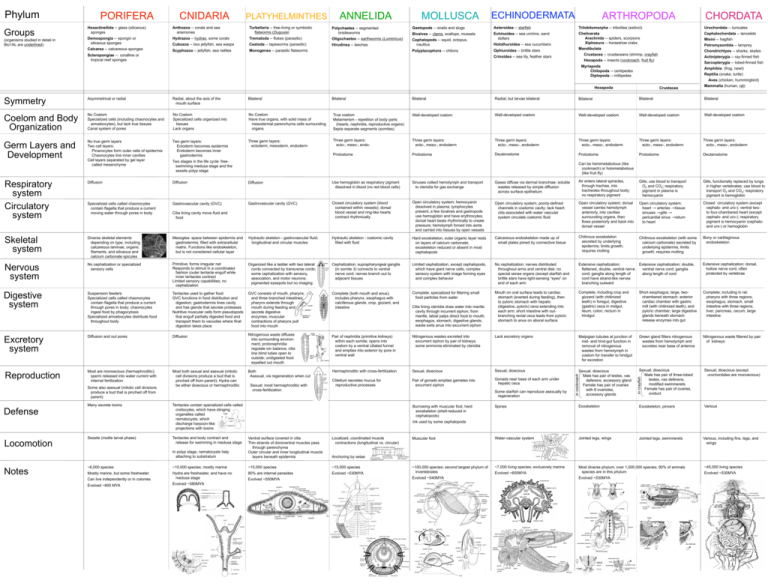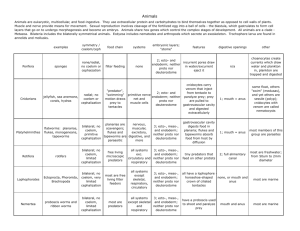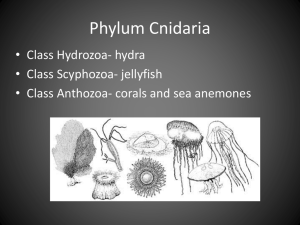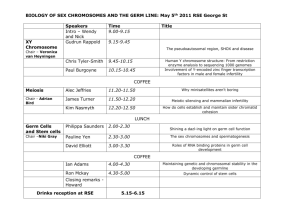Animal Phylum poster Porifera
advertisement

Phylum Groups (organisms studied in detail in Bio1AL are underlined) PORIFERA CNIDARIA PLATYHELMINTHES ANNELIDA MOLLUSCA ECHINODERMATA Hexactinellida -- glass (siliceous) sponges Anthozoa -- corals and sea anemones Turbellaria -- free-living or symbiotic flatworms (Dugusia) Polychaetes -- segmented bristleworms Gastopods -- snails and slugs Asteroidea -- starfish Bivalves -- clams, scallops, mussels Demospongia -- spongin or siliceous sponges Hydrazoa -- hydras, some corals Trematoda -- flukes (parasitic) Oligochaetes -- earthworms (Lumbricus) Cubozoa -- box jellyfish, sea wasps Cestoda -- tapeworms (parasitic) Calcarea -- calcareous sponges Hirudinea -- leeches Cephalopods -- squid, octopus, nautilus Echinoidea -- sea urchins, sand dollars Scyphozoa -- jellyfish, sea nettles Monogenea -- parasitic flatworms Polyplacophora -- chitons Scleropongiae -- coralline or tropical reef sponges Holothuroidea -- sea cucumbers Ophiuroidea -- brittle stars Crinoidea -- sea lily, feather stars ARTHROPODA Trilobitomorpha -- tribolites (extinct) Chelicerata Arachnida -- spiders, scorpions Xiphosura -- horseshoe crabs Mandibulata Crustacea -- crustaceans (shrimp, crayfish Hexapoda -- insects (cockroach, fruit fly) Myriapoda Chilopoda -- centipedes Diplopoda -- millipedes Hexapoda Crustacea CHORDATA Urochordata -- tunicates Cephalochordata -- lancelets Mixini -- hagfish Petromyzontida -- lamprey Chondrichtyes -- sharks, skates Actinipterygia -- ray-finned fish Sarcopterygia -- lobed-finned fish Amphibia (frog, newt) Reptilia (snake, turtle) Aves (chicken, hummingbird) Mammalia (human, rat) Symmetry Asymmetrical or radial Radial, about the axis of the mouth surface Bilateral Bilateral Bilateral Radial; but larvae bilateral Bilateral Bilateral Bilateral Coelom and Body Organization No Coelom Specialized cells (including chaonocytes and amoebocytes), but lack true tissues Canal system of pores No Coelom Specialized cells organized into tissues Lack organs No Coelom Have true organs, with solid mass of mesodermal parenchyma cells surrounding organs True coelom Metamerism - repetition of body parts (hearts, nephridia, reproductive organs) Septa separate segments (somites) Well-developed coelom Well-developed coelom Well-developed coelom Well-developed coelom Well-developed coelom Germ Layers and Development No true germ layers Two cell layers: Pinacocytes form outer cells of epidermis Chaonocytes line inner cavities Cell layers separated by gel layer called mesenchyme Two germ layers: Ectoderm becomes epidermis Endoderm becomes inner gastrodermis Three germ layers: ectoderm, mesoderm, endoderm Three germ layers: ecto-, meso-, endo- Three germ layers: ecto-, meso-, endoderm Three germ layers: ecto-, meso-, endoderm Three germ layers: ecto-, meso-, endoderm Three germ layers: ecto-, meso-, endoderm Three germ layers: ecto-, meso-, endoderm Protostome Protostome Deuterostome Protostome Protostome Deuterostome Respiratory system Circulatory system Diffusion Diffusion Diffusion Use hemoglobin as respiratory pigment dissolved in blood (no red blood cells) Sinuses collect hemolymph and transport to ctenidia for gas exchange Gases diffuse via dermal branchiae; soluble wastes released by simple diffusion across surface epithelium Air enters lateral spiracles, through trachea, into tracheoles throughout body; no respiratory pigment Gills; use blood to transport O2 and CO2; respiratory pigment in plasma is hemocyanin Gills, functionally replaced by lungs in higher vertebrates; use blood to transport O2 and CO2; respiratory pigment is hemoglobin Specialized cells called chaonocytes contain flagella that produce a current moving water through pores in body Gastrovascular cavity (GVC) Gastrovascular cavity (GVC) Closed circulatory system (blood contained within vessels); dorsal blood vessel and ring-like hearts contract rhythmically Open circulatory system; hemocyanin dissolved in plasma; lymphocytes present; a few bivalves and gastropods use hemoglobin and have erythrocytes; dorsal heart beats rhythmically to create pressure; hemolymph forced into aorta and carried into tissues by open vessels Open circulatory system; poorly-defined channels in coelomic cavity; lack heart; cilia associated with water vascular system circulate coelomic fluid Open circulatory system; dorsal vessel carries hemolymph anteriorly, into cavities surrounding organs, then flows posteriorly and back into dorsal vessel Open circulatory system; heart → arteries →tissue sinuses →gills → pericardial sinus →return to heart Closed circulatory system (except cephalo- and uro-); ventral twoto four-chambered heart (except cephalo- and uro-); respiratory pigment is hemocyanin (cephaloand uro-) or hemoglobin Skeletal system Diverse skeletal elements depending on type, including calcareous laminae, organic filaments, and siliceous and calcium carbonate spicules Mesoglea: space between epidermis and gastrodermis; filled with extracellular matrix. Functions like endoskeleton, but is not considered cellular layer Hydraulic skeleton - gastrovascular fluid; longitudinal and circular muscles Hydraulic skeleton - coelomic cavity filled with fluid Hard exoskeleton; outer organic layer rests on layers of calcium carbonate; exoskeleton reduced or absent in most cephalopods Calcareous endoskeleton made up of small plates joined by connective tissue Chitinous exoskeleton secreted by underlying epidermis; limits growth; requires molting Chitinous exoskeleton (with some calcium carbonate) secreted by underlying epidermis; limits growth; requires molting Bony or cartilaginous endoskeleton Nervous system No cephalization or specialized sensory cells Primitive; forms irregular net Responds to stimuli in a coordinated fashion (outer tentacle engulf while inner tentacles contract Limited sensory capabilities; no cephalization Organized like a ladder with two lateral cords connected by transverse cords; some cephalization with sensory, association, and motor neurons; pigmented eyespots but no imaging Cephalization; suprapharyngeal ganglia (in somite 3) connects to ventral nerve cord; nerves branch out to adjacent tissues Limited cephalization, except cephalopods, which have giant nerve cells, complex sensory system with image forming eyes and complex behavior No cephalization; nerves distributed throughout arms and central disk; no special sense organs (except starfish and brittle stars have light-sensing “eyes” on end of each arm Extensive cephalization; flattened, double, ventral nerve cord; ganglia along length of cord have strand-like nerves branching outward Extensive cephalization; double, ventral nerve cord; ganglia along length of cord Extensive cephalization; dorsal, hollow nerve cord; often protected by vertebrae Digestive system Suspension feeders Specialized cells called chaonocytes contain flagella that produce a current through pores in body; chaonocytes ingest food by phagocytosis Specialized amoebocytes distribute food throughout body Tentacles used to gather food GVC functions in food distribution and digestion; gastrodermis lines cavity and has glands that secrete proteases Nutritive muscular cells form pseudopods that engulf partially digested food and transport them to vacuoles where final digestion takes place GVC consists of mouth, pharynx, and three branched intestines; pharynx extends through mouth during feeding and secrete digestive enzymes; muscular contractions of pharynx pull food into mouth Complete (both mouth and anus); includes pharynx, esophagus with calciferous glands, crop, gizzard, and intestine Complete; specialized for filtering small food particles from water Mouth on oral surface leads to cardiac stomach (everted during feeding), then to pyloric stomach with hepatic (digestive, pyloric) ceca extending into each arm; short intestine with outbranching rectal ceca leads from pyloric stomach to anus on aboral surface Complete; including crop and gizzard (with chitinized teeth) in foregut, digestive (gastric) ceca in midgut, ileum, colon, rectum in hindgut Short esophagus; large, twochambered stomach: anterior cardiac chamber with gastric mill (with chitinized teeth), and pyloric chamber; large digestive glands beneath stomach release enzymes into gut Complete; including in rat: pharynx with three regions, esophagus, stomach, small intestine with three regions, liver, pancreas, cecum, large intestine Excretory system Diffusion and out pores Diffusion Nitrogenous waste diffuses into surrounding environment; protonephridia regulate ion balance; cilia line blind tubes open to outside; undigested food expelled out mouth Pair of nephridia (primitive kidneys) within each somite; opens into coelom by a ventral ciliated funnel and empties into exterior by pore in ventral wall Nitrogenous wastes excreted into excurrent siphon by pair of kidneys; some ammonia eliminated by ctenidia Lack excretory organs Malpigian tubules at junction of mid- and hind-gut function in removal of nitrogenous wastes from hemolymph in coelom for transfer to hindgut for excretion Green gland filters nitrogenous wastes from hemolymph and excretes near base of antenna Nitrogenous waste filtered by pair of kidneys Reproduction Most are monoecious (hermaphroditic); sperm released into water current with internal fertilization Most both sexual and asexual (mitotic cell divisions produce a bud that is pinched off from parent); Hydra can be either dioecious or hermaphroditic Both Asexual, via regeneration when cut Hermaphroditic with cross-fertilization Sexual; dioecious Sexual; dioecious Pair of gonads empties gametes into excurrent siphon Gonads near base of each arm under hepatic ceca Sexual; dioecious Male has pair of three-lobed testes, vas deferens, modified swimmerets Female has pair of ovaries, oviduct Sexual; dioecious (except urochordates are monoecious) Clitellum secretes mucus for reproductive processes Sexual; dioecious Male has pair of testes, vas deferens, accessory gland Female has pair of ovaries with 8 ovarioles, accessory glands Defense Locomotion Notes Many secrete toxins Sessile (motile larval phase) Cilia lining cavity move fluid and food Sexual; most hermaphroditic with cross-fertilization Some starfish can reproduce asexually by regeneration Tentacles contain specialized cells called cnidocytes, which have stinging organelles called nematocysts, which discharge harpoon-like projections with toxins Tentacles and body contract and release for swimming in medusa stage Cilia lining ctenidia draw water into mantle cavity through incurrent siphon; from mantle, labial palps direct food to mouth; esophagus, stomach, digestive glands; waste exits anus into excurrent siphon in crayfish Can be hemimetabolous (like cockroach) or holometabolous (like fruit fly) in cockroach Some also asexual (mitotic cell divisions produce a bud that is pinched off from parent) Two stages in the life cycle: freeswimming medusa stage and the sessile polyp stage Spines Exoskeleton Exoskeleton; pincers Various Muscular foot Water-vascular system Jointed legs, wings Jointed legs, swimmerets Various, including fins, legs, and wings ~100,000 species; second largest phylum of invertebrates ~7,000 living species; exclusively marine Most diverse phylum; over 1,000,000 species; 90% of animals species are in this phylum Burrowing with muscular foot; hard exoskeleton (shell-reduced in cephalopods) Ink used by some cephalopods Localized, coordinated muscle contractions (longitudinal vs. circular) In polyp stage, nematocysts help attaching to substratum Ventral surface covered in cilia Thin strands of dorsiventral muscles pass through parenchyma Outer circular and inner longitudinal muscle layers beneath epidermis ~6,000 species ~10,000 species, mostly marine ~15,000 species ~15,000 species Mostly marine, but some freshwater 80% are internal parasites Evolved ~530MYA Can live independently or in colonies Hydra are freshwater, and have no medusa stage Evolved ~600 MYA Evolved ~580MYA Evolved ~550MYA Anchoring by setae Evolved ~540MYA Evolved ~600MYA Evolved ~530MYA ~45,000 living species Evolved ~530MYA







